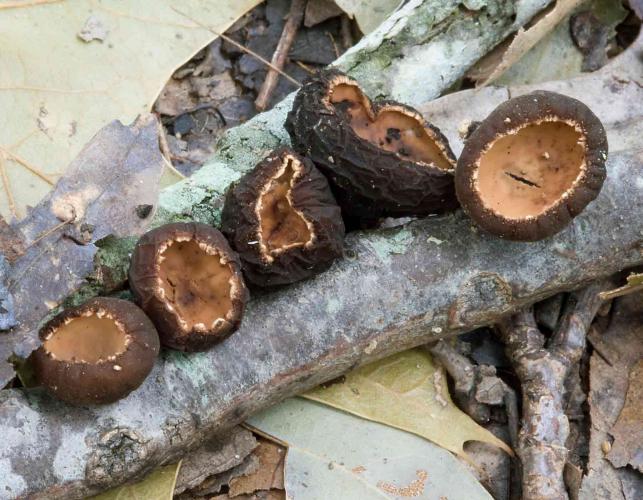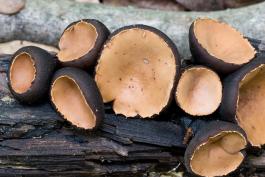
Cup-shaped; inside surface reddish to brownish; outside blackish brown and hairy. It grows in clusters on dead deciduous wood. July–September. Cup closed and urn-shaped when immature, then opening to become a shallow cup; outer surface blackish brown and hairy; inner surface reddish to chocolate brown; texture tough and rubbery; flesh is rubbery, gelatinous, and sometimes squishy. Stalk (if present) thick; blackish brown; with a dense covering of hairs. Spore print reddish brown. Spores magnified are elliptical, with narrow ends and tiny warts.
Lookalikes: Devil’s urn (Urnula craterium) has a blackish inner surface and fruits in the spring. There are other brown to black cup fungi, but none with thick, gelatinous flesh.
Cup width: ¾–1¼ inches; stalk length: to ¾ inch; stalk width: to 5⁄8 inch.

Statewide.
Habitat and Conservation
Grows clustered on dead deciduous wood, including sticks and small logs. When they grow on buried dead tree roots, it can look like they're growing out of the soil.
Status
Not edible.
Life Cycle
This species exists as a network of fungal cells (mycelium) within rotting wood. The mycelium obtains nourishment by digesting, and rotting, the wood. When ready to reproduce, the mycelium develops the cuplike "fruiting body"—the reproductive structure—outside the wood. Spores are produced inside the cup and are released to begin new mycelia elsewhere. The mycelium can live for decades.
Human Connections
Whether edible or not, fungi have important roles in nature, benefiting humans indirectly by keeping forests productive and healthy. They each also possess a strange beauty in color, texture, and form that humans can enjoy.
Ecosystem Connections
Fungi are vitally important for a healthy ecosystem. This fungus feeds on dead hardwoods such as oaks, decomposing their fallen logs, branches, and buried roots. This cleans the forest and helps nutrients to cycle back into the soil.








Mushrooms are a lot like plants, but they lack chlorophyll and have to take nutrients from other materials. Mushrooms are neither plants nor animals. They are in a different kingdom — the fungi. Fungi include the familiar mushroom-forming species, plus the yeasts, molds, smuts, and rusts.
Always be cautious when eating edible mushrooms. Be absolutely sure of the ID, and only eat a small amount the first time you try it to avoid a reaction..





















